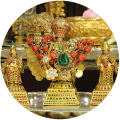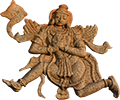Śrī Vidyāratnākara Tīrtha

Tenure : 1906 – 1915
Ārādhana : Vaiśākha kṛṣṇa navamī
Location : Sŏsale
Charama Shloka :
ದುರ್ವಾದಿಮತ್ತನಾಗೇಂದ್ರವಿದಾರಣಮೃಗಾಧಿಪಃ | ವಿದ್ಯಾರತ್ನಾಕರಗುರುಃ ಸನ್ನಿಧತ್ತಾಂ ಸದಾ ಹೃದಿ ||
दुर्वादिमत्तनागेंद्रविदारणमृगाधिपः | विद्यारत्नाकरगुरुः सन्निधत्तां सदा हृदि ||
durvādimattanāgendravidāraṇamṛgādhipaḥ | vidyāratnākaraguruḥ sannidhattāṃ sadā hṛdi ||
About Śrī Vidyāratnākara Tīrtha
Śrī Vidyāratnākara Tīrtha was ordained the 35th Pīṭhadhipati by Śrī Vidyāsamudra Tīrtha. He was known as Thekkaluru Ahobalācārya in Purvāśrama. His ancestors hail from a village located near Avināśi on the banks of River Kauśika. Śrī Vidyākānta Tīrtha happened to visit this village and was greatly impressed by the knowledge and personality of his father Śrī Lakṣmīnarasiṁhācārya. As desired by the saint, the whole family relocated to the Śrīmaṭha premises in Sosale Kśĕtra. The pandit was also married to the daughter of Śrī Rangappācārya – the saint’s Pūrvāśrama brother who ordained to the Pīta later as Śrī Vidyānidhi Tīrtha. After both the saints attained Haripāda, Śrī Vidypūrṇa Tīrtha ordained to the Pīṭha and blessed Śrī Lakṣmīnarasiṁhācārya with Mantropadeśa and directed him to perform service to Lord Nṛsiṁha at Ahobala Kṣetra for five years. The couple had a child in Hemalambi nama Saṁvatsara and named him Ahobalācārya as he was born by Lord’s blessings.
Ahobalācārya had all his Śāstraic education under the direct supervision of Śrī Vidyāpūrṇa Tīrtha at Sosale and was taught its specialities – Nyāya, Kāvya, Vyākaraṇa, Alaṅkara etc. by none other than Śrī Garalapuri Śāstri – advisor to the Mysore Kings. He had his upanayana at the age of five and being a child prodigy, mastered the four vedas along with Śadaṅgas by the age of fourteen. He had further education in Vedanta from Śrī Bhīmasĕnācārya – who later succeeded the Pīṭha as Śrī Vidyāśrīdhara Tīrtha – and turned out to be a scholar-par-excellence at a very young age. During the period of famine (1887 CE), he donated everything to assist the Śrīmaṭha activities and later undertook an extensive tour of Tamilnadu to impart his knowledge to disciples at Erode, Salem, Śrīraṅgam, Kumbhakŏṇam. However, as ordained by fate, the Ācārya experienced extreme personal tragedies in life. Taking all this as ordained by God, the Ācārya couple performed special prayers to beseech the Lord and Lordess at Nāmagiri, obtained their blessings, and begot children and settled down at Coimbatore.
By this time, Śrī Vidyāsamudra Tīrtha – presiding saint for the Śrīmaṭha – proposed that Ācārya should succeed him on the Pīṭha. However, Ācārya declined this proposal on each occasion citing different reasons as his inappropriateness, inability to continue his intellectual pursuits due to Śrīmaṭha responsibilities and the like. However, Mūla Gopālakṛṣṇa Devaru appeared in Ācārya’s dream and commanded that he should ascend the Pīṭha. Śrī Vidyāsamudra Tīrtha then ordained the Ācārya to the fourth order and placed him on the pita as Śrī Vidyāratnākara Tīrtha.
The saint was a perfect example for sainthood as he possessed all the required qualities and repeatedly demonstrated them on several occasions. During his tenure, Śrīmaṭha was rich from both perspectives – spiritual and financial – and its name and fame were at their zenith. Being a luminary on all facets of Sanātana Dharma – Siddhānta, Sangīta and Sāhitya – the saint was honoured with several titles from different quarters as Śāstra Pravacana Nidhi, Sakalakalā Bhāskara etc.
We understand from tradition that the saint was a winsome personality and renowned scholars across the spectrum of life used to flock the doors of Śrīmaṭha. Besides Śrīmaṭha scholars such as Gŏwḍagere Vĕnkaṭaramaṇācārya, Śrīmuśnam Gopālakṛṣṇācārya and Śyāmācārya, the other familiar names are Śrī Suguṇendra Tīrtha – Śrī Rāghavendra Swami Maṭha -, Śrī Hariyappācārya – Śrī Śrīpādarāja Maṭha,Composer Mysore Vāsudevācārya, Violinist T. Chowdiah and many others.
The saint was a prolific composer on both Saṁskṛta and Kannaḍa. His works basically come in different forms: Succinct summary of some of the most important facets of Mādhva as well as the Śrīmaṭha tradition, Ślokas extolling Lord’s different forms and stalwarts of the Śrīmaṭha Guru Parampara, and several mellifluous devaranamas in either language with the Aṅkita – pseudonym – Nāmagiri Narahari. These compositions are a connosieur’s treat and even a cursory review of these works is sufficient to reveal the saint’s sublimity and pedigree.
As the saint ascended the Pīṭha at a late age of 69 years of age, most of his activities were intellectually oriented with less travel. The saint established a sabha named ‘Śrīmat Daśapramati Darśana Prakāśini’ and organized its first vidvat sadas at Bangalore in 1913. As the name suggests, the mission of the above organization was to spread the knowledge on Ācārya Madhva’s philosophy to one and all. This turned out to be a great success, was well-attended by scholars of the day, and was a pioneer for ones that came later.
The saint anointed Śrī Rāmācārya to the fourth order with the name Śrī Vidyāvāridhi Tīrtha and handed over the Pīṭha and attained Haripāda listening to the recitation of the last two chapters of Brahma Sutra Bhāśya . His Vṛndavana is consecrated at Sosale Kṣetra.
PS: Śrī Vidyāprasanna Tīrtha has composed an excellent Sanskrit composition on this saint.


